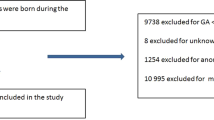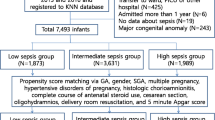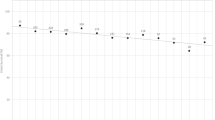Abstract
Objective:
Proper management of very low weight (<1500 g) infants requires specific expertise. During July and August, pediatric interns start new rotations and advance in responsibilities by postgraduate level. We test the hypothesis that low weight births in teaching hospitals exhibit increased neonatal mortality during the initial training months.
Study Design:
Population-based cohort of 5184 very low weight and 15 232 moderately low weight infants in California from 19 regional teaching hospitals with medical training programs. Logistic regression methods controlled for both individual covariates and temporal patterns in neonatal mortality.
Result:
We found no difference in neonatal mortality between very low weight infants born in teaching hospitals during July and August and those born in other months (adjusted odds ratio (AOR): 0.98, 95% confidence interval (CI), 0.78 to 1.23). Investigation of moderately low birth weight infants also indicated no increased neonatal mortality.
Conclusion:
Infants most likely to die in the neonatal period do not appear to be at elevated risk of neonatal mortality during July and August.
This is a preview of subscription content, access via your institution
Access options
Subscribe to this journal
Receive 12 print issues and online access
$259.00 per year
only $21.58 per issue
Buy this article
- Purchase on Springer Link
- Instant access to full article PDF
Prices may be subject to local taxes which are calculated during checkout
Similar content being viewed by others
References
Rich EC, Gifford G, Luxenberg M, Dowd B . The relationship of house staff experience to the cost and quality of inpatient care. J Am Med Assoc 1990; 263: 953–957.
Claridge JA, Schulman AM, Sawyer RG, Ghezel-Ayagh A, Young JS . The ‘July phenomenon’ and the care of the severely injured patient: fact or fiction? Surgery 2001; 130: 346–353.
Borenstein SH, Choi M, Gerstle JT, Langer JC . Errors and adverse outcomes on a surgical service: what is the role of residents? J Surg Res 2004; 122: 162–166.
Barry WA, Rosenthal GE . Is there a July phenomenon? The effect of July admission on intensive care mortality and length of stay in teaching hospitals. J Gen Intern Med 2003; 18: 639–645.
Ford AA, Bateman BT, Simpson LL, Ratan RB . Nationwide data confirms absence of ‘July phenomenon’ in obstetrics: it's safe to deliver in July. J Perinatol 2007; 27: 73–76.
Buchwald D, Komaroff AL, Cook EF, Epstein AM . Indirect costs for medical education. Is there a July phenomenon? Arch Intern Med 1989; 149: 765–768.
Griffith 3rd CH, Wilson JF, Desai NS, Rich EC . Does pediatric housestaff experience influence tests ordered for infants in the neonatal intensive care unit? Crit Care Med 1997; 25: 704–709.
Myles TD . Is there an obstetric July phenomenon? Obstet Gynecol 2003; 102: 1080–1084.
Apostolidou I, Katsouyanni K, Touloumi G, Kalpoyannis N, Constantopoulos A, Trichopoulos D . Seasonal variation of neonatal and infant deaths by cause in Greece. Scand J Soc Med 1994; 22: 74–80.
Matsuda S, Kahyo H . Seasonality of preterm births in Japan. Int J Epidemiol 1992; 21: 91–100.
Mathews TJ, MacDorman MF . Infant mortality statistics from the 2004 period linked birth/infant death data set. Natl Vital Stat Rep 2007; 55: 1–32.
California Department of Health Services, Center for Health Statistics. Birth Cohort Public Use File, 1999–2003. Sacramento, CA, 2006.
California Children's Services. CCS approved neonatal intensive care units. Department of Health Services, Children's Medical Services, California Children's Services: Sacramento, CA, 2000, pp 1–29.
Catalano R, Serxner S . Time series designs of potential interest to epidemiologists. Am J Epidemiol 1987; 126: 724–731.
SAS Institute Inc.. Version 9.0.1. Cary, NC, 2006.
Liu L, Hudak G . Forecasting and Time Series Analysis Using the SCA Statistical System. Scientific Computing Associates: Villa Park, IL, 1994.
Pollack MM, Cuerdon TT, Patel KM, Ruttimann UE, Getson PR, Levetown M . Impact of quality-of-care factors on pediatric intensive care unit mortality. J Am Med Assoc 1994; 272: 941–946.
Acknowledgements
The Ruth L Kirschstein National Research Service Award (within the Agency for Health Care Research and Quality) supported the analyses described in this manuscript. We thank Ralph Catalano for statistical assistance and for valuable comments on earlier versions of this manuscript. We are also indebted to Elizabeth Anderson for data management of the Birth Cohort File.
Author information
Authors and Affiliations
Corresponding author
Additional information
Disclosure
The authors state no conflict of interest.
Rights and permissions
About this article
Cite this article
Bruckner, T., Carlo, W., Ambalavanan, N. et al. Neonatal mortality among low birth weight infants during the initial months of the academic year. J Perinatol 28, 691–695 (2008). https://doi.org/10.1038/jp.2008.72
Received:
Revised:
Accepted:
Published:
Issue Date:
DOI: https://doi.org/10.1038/jp.2008.72



